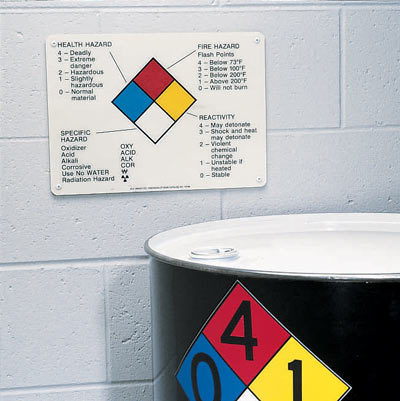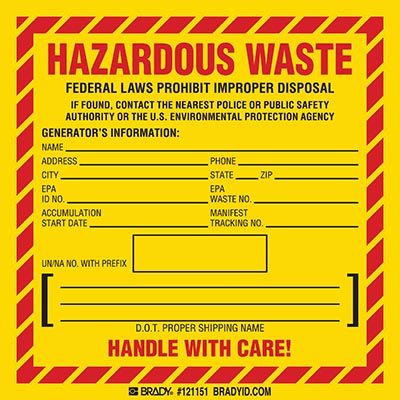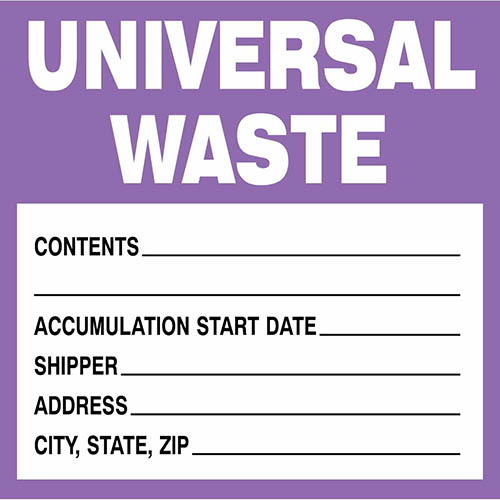Labels for Safety, Visual and Facility ID Desktop Printers
Hazardous waste label requirements —
comply with EPA/RCRA regulations
Proper identification and labeling is foundational to a safety manager’s success. They help blend speed and efficiency into operations and put information front and center for workers. Often, information that directly affects health and safety.
Hazardous waste labeling is no exception.
Hazardous waste labels warn of inherent danger if not disposed of or handled properly. Missing or inadequate labeling can produce fines, adverse health effects, environmental contamination and more. RCRA regulations and EPA labeling requirements ensure labels are uniform and effective.
Let’s explore the regulations that govern hazardous waste label requirements, required text (including a hazardous waste label example) and labeling best practices.
The history — hazardous waste labeling requirements began with RCRA regulations
Hazardous waste is a subset of solid waste that may be detrimental to human health or the environment. In the United States, the Resource Conservation and Recovery Act (RCRA) gives the Environmental Protection Agency (EPA) the authority to control hazardous waste from cradle to grave.
It can take many forms from many sources, such as the byproduct of a manufacturing process or a product that you use or encounter daily, from cleaning fluids to battery acid. This makes the term “solid waste” a misnomer, as it can exist as a solid, liquid, gas or sludge.
Hazardous wastes under RCRA regulations in Title 40 CFR, Part 261 are divided into two major categories:
- Listed wastes (F, K, U and P Lists)
- Characteristic wastes (ignitable, corrosive, reactive, toxic)
Reference the EPA’s Hazardous Waste Identification Process to determine if your material in question is a hazardous waste.

The basics — text that must be displayed
For non-bulk packaging of hazardous material, the EPA’s hazardous waste container labeling requirements state that a label must include:
- The following text: “HAZARDOUS WASTE–Federal Law Prohibits Improper Disposal. If found, contact the nearest police or public safety authority or the U.S. Environmental Protection Agency.”
- Generator’s name and address
- Generator’s EPA identification
- Manifest tracking number
While the EPA provides specific regulatory guidelines, there is no standardized format (e.g., colors, size or text order).
The fine print — labeling requirements vary by state
RCRA regulations allow states to develop more stringent regulatory programs. After review by the EPA, states may then be able to take over responsibility for implementation. As such, it’s important for you to check with your state’s authority having jurisdiction regarding hazardous waste labeling requirements and whether further guidelines exist.
The how-to — hazardous waste label example
While there are no requirements regarding size, color or format spelled out by the EPA, it’s best practice to make the label stand out so workers and inspectors are able to locate and identify hazardous waste effectively. Here’s an example of a commonly used hazardous waste label.
Browse a full collection of hazardous waste labels designed to stand out in your facility and help you stay compliant with hazardous waste label requirements.
The extras — additional labeling for hazardous waste

For transport
While the EPA regulates pre-transport requirements, the Department of Transportation (DOT) regulates requirements for hazardous waste once it’s in transport. For shipments of hazardous waste, the DOT requires each non-bulk package (maximum capacity no more than 119 gallons) to display, at a minimum:
- The proper shipping name and identification number of the hazardous material
- The name and address of the shipper and/or the designated recipient
- The diamond hazard labels for the primary (and most subsidiary) hazard classes of the hazardous material
Reference Title 49 CFR, Part 172 for more information and browse common right-to-know labels used during shipping.
Universal wastes
Universal wastes are hazardous waste that can be collected under streamlined collection standards. Federal universal waste regulations are found in Title 40 CFR, Part 273 and apply to five types:
- Batteries
- Pesticides
- Mercury-containing equipment
- Lamps
- Aerosol cans
The unsolicited advice — best practices for labeling
While you know your facility and needs best, here are some best practices for additional hazardous waste labeling requirements:
- Train all waste handlers on language, markings and labels
- Handwriting variable information is allowed, but avoid handmade labels, as these could become detached, faded or illegible more quickly over time
- Write legibly
- Don’t wait for transport to apply DOT required labels; do so at first deposit of waste
- Wash off or black out old markings/labels
- Include additional information about contents (e.g., toxic) when appropriate
- Stick to the minimum number of labels needed to maximize effectiveness, a hazardous material label printer can help your printing accuracy
The wrap-up — meet hazardous waste labeling requirements with Brady
Easy labeling and compliant labeling aren’t mutually exclusive – not when you trust the labeling experts. Rely on Brady for quality identification solutions that last. Shop our full assortment of hazardous waste labels or call or email anytime to speak with a labeling expert.
Simplify your hazardous waste labeling with these products
Resources

Workplace Hazard Communication
As workplace hazard communication evolves, you need to keep up to date to ensure safety.
Learn More







